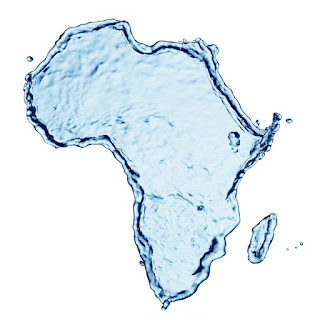Management and Flooding: the study case of Nigeria
One notable water paradox to analyze is the case of
Nigeria and their flood trends, a recurrent climate event that has been severe this
year. Indeed, it has been established that the 2022 floodings have been the worst of the
decade in Nigeria. This is
observable through the satellite imagery NASA provided of a comparison of
Southern Nigeria between 11th and 24th October 2022 (Figure 1),
where there is clear increase of water mass going through the Niger river,
severally damaging large surrounding cities such as Lokoja and Idah. In total,
the World Bank argue that these recurrent floodings have a direct impact on key
sectors such as agriculture, health, economy, and trade. The floodings also subsequently
lead to a spread of Cholera through flooding, as the contaminated water spread to clean bodies
of water.
Notable climate researchers have explained that the
damages of these floods in West Africa are strongly associated with a lack of governmental efforts to address these
environmental issues, significantly worsened by climate over a prolonged period
of time. Despite the present coping
strategies, they need to be urgently adapted to the changing environment, as
the National Emergency Management Agency (NEMA) in Nigeria has warned that more floodings of this gravity are expected next
year if insufficient actions are done. Furthermore,
the impacts of environmental change needs to be addressed, as Nigeria may lose
some land in the southern region. On the long term, the constantly rising sea
level is expected to significantly decrease land availability in Nigeria, as a
1 centimeter raise in the ocean levels could
submerge 75% of the Niger Delta land.
Figure 1: Satellite imagery of Southern Nigeria using from the 11th October 2022 (up) and 24th October 2022 (down)
Role of dams
So far, dams have found to reduce population exposure to extreme centennial floodings by 15%, and are used to regulate water flow of half of major water streams worldwide. However, the increasing frequency of water discharge form environmental change demonstrates that more needs to be done for floodings in drought prone countries such as Nigeria to better cope with these consistent natural disasters. This can be done by complementing the construction of dams with other approaches, such as reforestation, improved drainage systems, environmental sanitation through waste management and more.
Nigeria’s main approach of water collection is the use
of dams. So, where did
it go wrong for dams Nigeria? Well, one of the main problems lie within the management
of the dams, where many dams had not
been properly preserved in south-western Nigeria, and that many dams under construction
since the 1980s had not been completed. This lack of attention towards
mitigation strategies are seen in many other countries, where the correct
amount of attention is only given once the disaster has happened and
substantial funds are needed for repairs. Hopefully, the adequate measures will
be installed for 2023 and the expected heavy seasonal rain.





Comments
Post a Comment